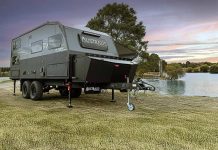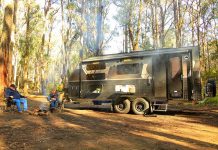When hitching up for a touring adventure, knowing we’ll be spending a lot of time in our vehicle, we aim to make that driving experience a bit more comfortable where possible. And as we can travel at all times of the year, it’s not uncommon for daytime temperatures to be anywhere from the 40 degrees to falling below 0 degrees. To make touring more comfortable, and to give ourselves better control of the extreme temperature variations in our vehicle, one of our first jobs before hitting the road is to fit our Solarscreens. If you haven’t heard of this accessory before, read on…
WHAT IS A SOLARSCREEN?
Fundamentally, Solarscreens are a type of window insulation that’s been designed to suit vehicles, motorhomes and boats. The screens are manufactured in Australia from nine layers of varying materials.
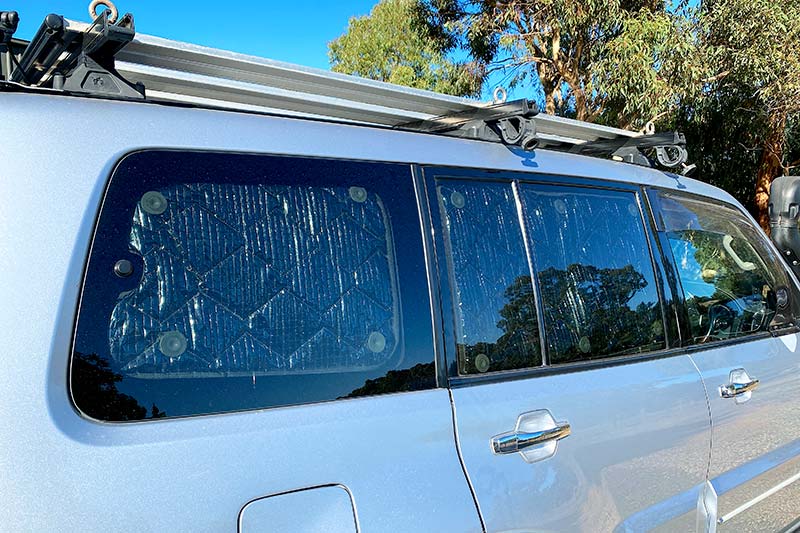
These layers are sewn together to form a soft quilted, padded screen. One side of the screen is a dense aluminium, which has highly reflective properties. The other side of the pad, facing inwards, is fitted with a soft PVC material that has anti-condensation properties. Dacron (an anti-allergic material) is also incorporated in the Solarscreen for its insulating properties.
Each of the screens is sewn and hemmed to the shape of the window opening, which ensures the job is a snug fit. The screens also have specially designed suction-cup discs that get fitted to each screen’s reinforced eyelet holes to help ensure the screens stay in place once fitted to the windows.
HOW SOLARSCREEN WORKS
Before installing the Solarscreen, it’s important to ensure the glass surfaces are clean to help the suction-cup discs stick. This can be done by wiping over the surfaces using some hot, soapy water before drying off with a cloth.
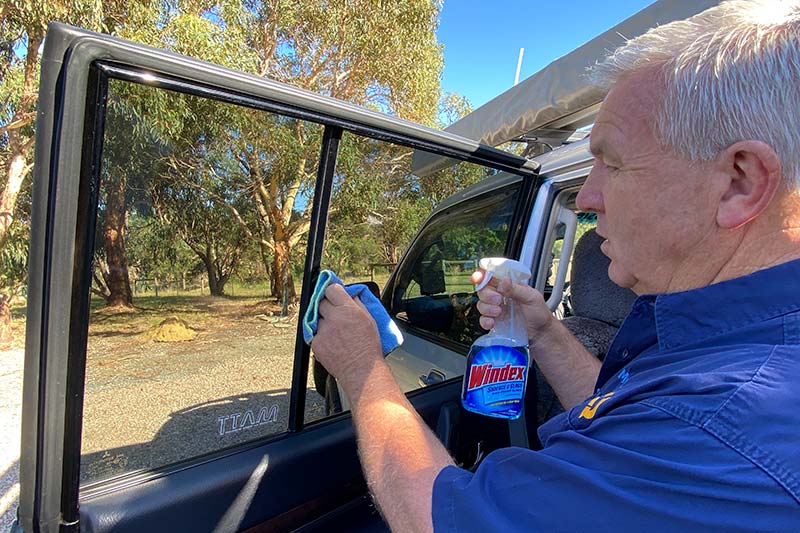
For a thorough clean, we like to give the glass surfaces another wipe over using either a glass cleaner or methylated spirits. It’s then a matter of fitting the screens by slightly moistening the suction discs and fitting the screen to the inside window face. Pushing the discs firmly is enough to create the suction required to hold the screen in place. This process is repeated until all the screens have been fitted.
The beauty of Solarscreens is they allow the doors to open and close freely without the need to remove the screens first. Once the screens have been installed, it’s time for the reflective pads to go to work. As the screens have reflective and insulating properties, they block harmful sun rays from entering through the vehicle’s glass and minimise heat transfer in the process.
WHAT WE THINK
It was during our first lap of the map years ago when we realised how hot the inside of a vehicle can get, especially up north. We tried all sorts of ways to stop the sun from getting in the vehicle. We tried things like cardboard, corflute, towels, and even simple windscreen shades.
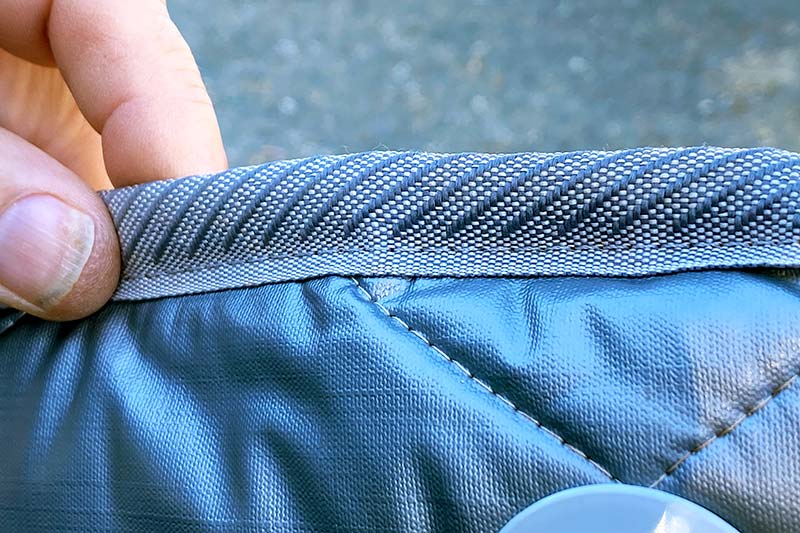
Each helped to some degree, but not anything to write home about. We stumbled across Solarscreen after seeing it being used on a 4WD in the Kimberley. We learnt how good they were after speaking with the vehicle’s owner, so we enquired about getting a set made for our Pajero. We remember the day we fitted them while staying in a Kununurra caravan park after collecting our parcel from a local post office. They fitted nice and snug around the Paj’s windows and door openings, and blocked the light and the direct sun. They worked a treat! The temperature difference inside the vehicle was noticed immediately, so we knew we were onto a good thing.
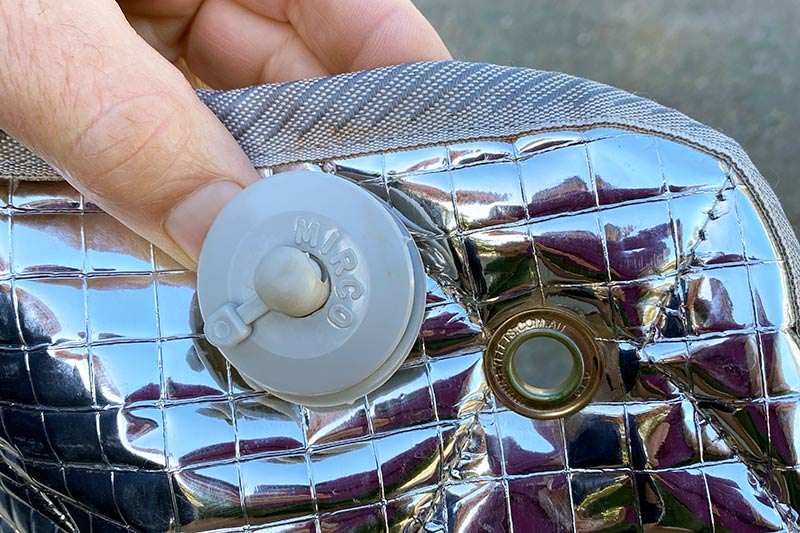
We’ve also found fitting Solarscreens has provided an additional bonus or two. Wagons, such as our Paj, have numerous large windows. We used to be somewhat conscious of travelling with a carload of gear that could easily be seen when left unattended. Although our vehicle’s windows are tinted, we’re grateful the screens further prevent prying eyes from seeing inside the vehicle. Another thing: we also like how the screens have helped with sound absorption. Acoustics inside the vehicle have also improved thanks to the screens, and they’ve also played a part in reducing outside road noise as well. Simple tasks like talking and listening to audiobooks or bopping along to our travel playlist tunes are even now more enjoyable.
Note: Consideration needs to be given when travelling with Solarscreens fitted in your vehicle as Australian states can differ with their regulations. We recommend checking with your appropriate authority prior to travelling as to the legalities of having them fitted in your vehicle during transit.
SUMMING UP
As Solarscreen is a small family-owned Aussie business, we like the fact we’re supporting local. And if you own a popular vehicle brand, you may find the screens available at their distributors around Australia. But if the screens need to be custom-made, you’ll find lead times can vary and generally take between two and six weeks.
Prices for the screens vary and depend on the vehicle type and the number of screens that you order. As a guide, our mid-sized Pajero screen kit came with five screens and a bag, costing under $300 plus postage. From our experience, Solarscreens are a great investment. They’ve got you covered all year round no matter where you’re travelling.
More information: www.solarscreen.com.au


